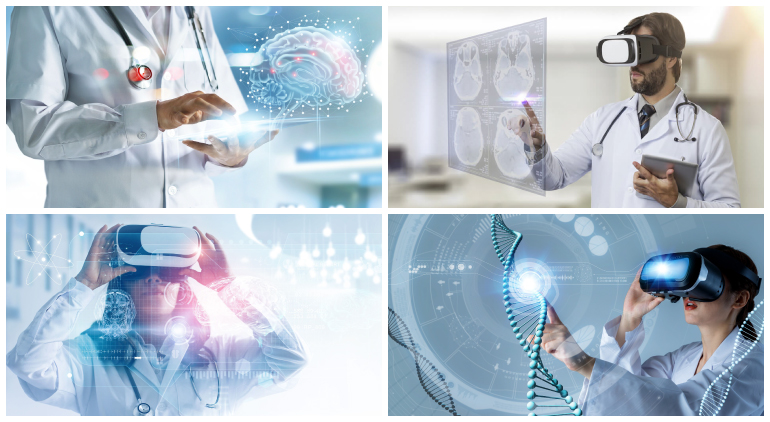Virtual Reality (VR) has evolved far beyond gaming and entertainment; it has found a profound application in healthcare. In recent years, VR technology has been making waves in the medical field, offering new and innovative ways to enhance medical procedures and therapy. In this blog post, we will delve into the remarkable ways in which VR is revolutionizing healthcare, improving patient outcomes, and providing a more immersive and effective approach to medical treatment.
The Rise of Virtual Reality in Healthcare
Virtual Reality, a technology that immerses users in computer-generated environments, has become a game-changer in the healthcare sector. It leverages the power of immersive experiences to benefit both patients and healthcare professionals. Here are some of the key areas where VR is making a significant impact:
- Enhanced Surgical Precision
Surgeons are now using VR to plan and simulate complex procedures before they step into the operating room. This technology allows them to visualize patient anatomy in 3D, making it easier to identify potential challenges and develop effective strategies. With VR, surgeons can practice intricate surgeries repeatedly, refining their skills and improving patient safety. - Pain Management and Therapy
Virtual Reality is proving to be a valuable tool in pain management and therapy. Patients undergoing painful treatments or recovering from injuries can benefit from immersive VR experiences that distract them from discomfort. VR therapy can also help individuals cope with anxiety, depression, and post-traumatic stress disorder by providing a calming and controlled environment for therapy sessions. - Rehabilitation and Physical Therapy
Rehabilitation is a crucial part of the recovery process for many patients. VR-based rehabilitation programs offer interactive exercises and activities that make the process engaging and motivating. Patients can work on improving their mobility, balance, and coordination in a virtual environment, making therapy sessions more enjoyable and effective. - Medical Education and Training
VR has transformed medical education and training by providing a realistic and immersive learning experience for aspiring healthcare professionals. Medical students can explore virtual anatomy, practice surgical procedures, and even interact with virtual patients to develop their clinical skills. This technology bridges the gap between theory and practice, ensuring that future doctors and nurses are better prepared for real-life medical scenarios. - Pain Distraction During Procedures
Medical procedures can be stressful and painful for patients, especially children. VR is being used to distract patients during various procedures, such as blood draws, injections, and dental work. By immersing patients in a captivating VR world, healthcare providers can reduce anxiety and discomfort, making the process more bearable. - PTSD Treatment for Veterans
Post-traumatic stress disorder (PTSD) is a challenging condition to treat. VR therapy has shown promising results in helping veterans and trauma survivors confront and manage their PTSD symptoms. Through carefully designed VR scenarios, patients can gradually expose themselves to traumatic memories in a controlled and therapeutic setting, allowing for desensitization and healing. - Remote Consultations and Telemedicine
The COVID-19 pandemic accelerated the adoption of telemedicine, and VR has played a significant role in making remote consultations more immersive and effective. Patients can virtually meet with their healthcare providers, and doctors can use VR to visualize patient data, conduct remote examinations, and collaborate with colleagues across the globe.
The Future of Healthcare: VR-Driven Advancements
As VR technology continues to advance, we can expect even more innovative applications in healthcare. Here are some exciting possibilities on the horizon:
- Customized Treatment Plans
VR can help tailor treatment plans to individual patients’ needs. By analyzing patient data and preferences, VR can create personalized therapy sessions and rehabilitation exercises that are more engaging and effective. - Improved Pain Assessment
Virtual Reality can be used to monitor and assess pain levels in patients more accurately. By tracking movements, facial expressions, and physiological responses during VR therapy sessions, healthcare providers can gather valuable data to fine-tune pain management strategies. - Remote Surgery Assistance
Surgeons can benefit from VR’s real-time, remote collaboration capabilities. Experts from around the world can virtually assist in surgeries, providing guidance and expertise during complex procedures, ultimately improving patient outcomes. - VR Pharmacies
Virtual Reality can enhance the pharmaceutical experience by allowing patients to explore medications and their potential side effects in a virtual environment. This can lead to better medication adherence and improved understanding of treatment regimens.
Conclusion
Virtual Reality is not just a tool for gaming and entertainment; it’s a transformative force in healthcare. From enhancing surgical precision to improving pain management and therapy, VR is offering new hope and opportunities for patients and healthcare professionals alike. As technology continues to evolve, we can anticipate even more groundbreaking advancements in the field of healthcare, driven by the immersive power of Virtual Reality. The future of medicine is looking brighter and more immersive than ever before.



